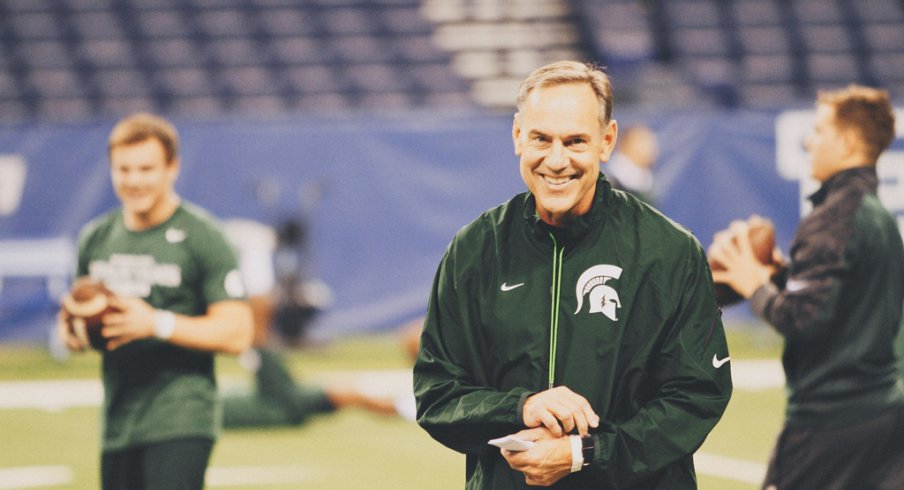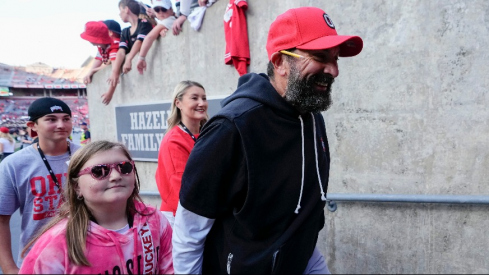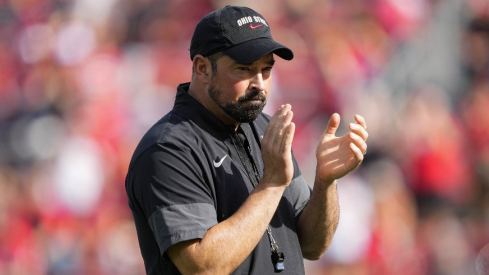After my third cup of lukewarm pressbox coffee and some time during the third quarter of Ohio State’s massacre of Purdue last season, I finally realized the true depth of the Big Ten’s downward spiral.
The Buckeyes were toying with the hapless Boilermakers the way most competent teams toy with the hapless Boilermakers. But on this cool late-October Saturday afternoon at Ross-Ade Stadium, Urban Meyer’s club was particularly saucy.
It was comical. And for a beat writer with no emotional or personal investment in the outcome of the contest, it was a chance to file an easy, straightforward recap and flee West Lafayette. Thank you football gods.
Most of all, though, it was sad. Not like boo-hoo sad. I mean pitiful sad.
Face it: the Big Ten stinks. It’s top heavy — fat and bloated above the belt and propped up with frail chicken legs below it.
Aside from Ohio State, Michigan State, Wisconsin and Nebraska, the rest of the conference ranges from mediocre to bad to offensive.
Power programs like Michigan, Penn State and Iowa aren’t headliners anymore.
Purdue and Illinois are floundering at the bottom of the conference like a dying fish flapping on the shoreline after being plucked from water.
Northwestern’s been markedly better, but took two steps back last season. Indiana’s had an offensive renaissance, but the Hoosiers are leaps and bounds away from being able to compete with the big boys. Minnesota's forgettable and irrelevant. Maryland and Rutgers look like they might dilute and already weak league.
It’s a festering on-field crisis the Big Ten can’t fix by throwing more money at it.
And, ironically, it’s one that can be at least partially remedied far away from the sideline and in the comfortable offices of the conference’s athletic directors.
The Effect of Turnover
In a win-now-or-else and what-have-you-done-for-me-lately climate, college football coaches sometimes seem to be on the hotseat as quickly as they were hired.
For a bagful of reasons, the Big Ten has been a nest for turnover in the last five years.
It’s why the conference is littered with relatively inexperienced and unheralded coaches.
The average years coached at a school is four and the spectrum begins with incoming Penn State coach James Franklin and ends with longtime Iowa coach Kirk Ferentz.
| Avg Tenure | 4 |
|---|---|
| Most tenured | 15 (Kirk Ferentz) |
| Least Tenured | 0 (James Franklin) |
It should also be noted, of course, the Big Ten has few coaches as tenured as Ferentz.
In fact, the next closest is Northwestern coach Pat Fitzgerald, who's been in Evanston, since 2006. Michigan State coach Mark Dantonio's been with the Spartans since 2007.
The rest of the bunch? Not so much.
In fact, 10 Big Ten coaches have been with their current employer for three or fewer seasons.
Here’s a bio blast for reference:
- Urban Meyer (two seasons): He's 24-2 at Ohio State but no Big Ten titles or bowl wins. Buckeyes are probably team to beat in the conference next season.
- Mark Dantonio (seven seasons): Led Michigan State to the Rose Bowl after knocking off the mighty Buckeyes a month earlier in the Big Ten championship game in Indianapolis. Can appreciate “Type of Way.” Can smile.
- James Franklin (entering first season): Hasn’t coached a down for Penn State but has launched some sort of recruiting holy war against Ohio State and forced the rest of the conference — and even the nation — to reckon with a Nittany Lions program that was sanctioned back to the Vietnam war.
- Pat Fitzgerald (eight seasons): Turned Northwestern from a bonafide cellarr dweller into a competitive program. After playing in what some dubbed as the biggest game in program history against Ohio State, the Wildcats lost their last seven contests after a 5-0 start last season.
- Gary Anderson (one season): Following Bret Bielema’s sudden departure to Arkansas, Andersen did a fine job of steering Wisconsin to a 9-4 year. The Badgers seem to be in good hands with him.
- Bo Pelini (six seasons): After a year of public relations nightmares and essentially daring the powers that be to fire him, Pelini is restoring his image with cats. But in all seriousness, he’s revived a previously dormant Nebraska program but has fallen short of the high-standing expectations of Cornhusker fans.
- Brady Hoke (three seasons): Michigan is a shadow of its former self both on the field and in the stands. After beating Ohio State for the second time in a decade and leading the Wolverines to a Sugar Bowl win in 2011, Hoke finds himself on the hot seat after back-to-back disappointing seasons and losses to the Buckeyes.
- Jerry Kill (three seasons): He’s ushered in steady improvement, but Minnesota won without him last season. The Golden Gophers feel like even more of an afterthought in a conference that’s getting bigger and bigger.
- Kirk Ferentz (15 seasons): Arguably the most overpaid coach in college football. Iowa has become a power program under his direction but the Hawkeyes have fallen off a cliff since the 2009 season.
- Randy Edsall (three seasons): Maryland’s shown incremental improvement under his guidance but the Terps are still very much an average to below average football team.
- Kevin Wilson (three seasons): Has ushered in an explosive offense but the Hoosiers have major holes and issues on defense. Also, Indiana isn't getting the talent Ohio State, Michigan State or Penn State has any time soon.
- Kyle Flood (two seasons): Took over after Greg Schiano jumped to the NFL. Went 9-4 in his first year and 6-7 last season.
- Tim Beckman (two seasons): His 6-18 record has largely been a disappointment for even a program as dysfunctional as Illinois.
- Darrell Hazell (one season): The former Ohio State assistant is charged with rebuilding a Purdue program that’s made a home for itself at rock bottom.
I repeat: 10 Big Ten coaches have been with their current employer for three or fewer seasons.
It's reflective of a conference that's undergone profound change in the last five or six years. A league once marked by stalwart coaches now features a slew of orchestrators in the embryonic state of building any program — regardless of success at previous stops.
Coaching pillars like Jim Tressel, Joe Paterno and Llyod Carr are gone. And since their respective departures, only the Buckeyes have managed to mitigate the damage that is losing the foundation and epicenter of an organization.
But schools like Michigan and Penn State can and have, to various degrees, pushed through the rubble. The Wolverines had success in Brady Hokes's first season and, before he jumped at a chance to coach the Houston Texans, Bill O'Brien probably was the only thing keeping the Nittany Lions from falling into a black hole.
And most of all, these kinds of schools have the tools to emerge from such wreckage. They're blue blood programs that can lure big-time coaches despite the craziest of circumstances. Michigan is still Michigan. Penn State is still Penn State. They're brands. Those stadiums are still huge. The football-crazed culture is still there.
No, they aren't doing the conference any favors by fielding out an average product on Saturdays. But the Big Ten isn't bad because of them.
The crux of the problem lies with the conference's weakest programs and how turnover is a self-inflicted. It's a vicious cycle of mediocrity.
Patience is a Virture
While it's abundantly clear turnover has plagued the conference from top to bottom, it's an inevitable and sometimes natural problem.
Where the Big Ten seems to struggle is with how its weakest programs handle the phenomena.
There are reasons for why that is: lack of recent success, lack of historical success, lack of a football culture. Few probably have "visit Ross-Ade Stadium" or "tour Illinois' locker rooms" on their bucket list.
Another explanation is exploring how the traditionally-weaker teams have handled themselves in the ongoing coaching carousel that is modern day college football.
In just the last six or seven years:
Purdue hired Danny Hope to usher in a new era of Boilermaker ball before ousting him after four seasons.
Illinois poached Tim Beckman to try and right a ship left to sink by Ron Zook but now Beckman's fighting for his coaching life after two bad seasons in Champaign.
Stinky Indiana hired stinky Bill Lynch in 2007, fired him after four miserable seasons, gobbled up Kevin Wilson and now demands Wilson turn around decades of futility.
Minnesota canned Tim Brewster before he could even finish his fourth season before bringing in Jerry Kill.
See the pattern?
The bottom half of the Big Ten is as stable as a game of Jenga. And in a league that's desperate emerge from the muck of mediocrity, it becomes a cycle.
Bad programs are bad to begin with. Then they get bad coaches or young coaches who aren't properly equipped to succeed in an already bad place. Bad coaches don't win games. Bad coaches have bad seasons. Bad coaches can't recruit kids to play at a traditionally bad program that just had another bad season. Bad coaches get average to bad recruits to play for them. Bad recruits don't win football games against the likes of Michigan State, Ohio State, Wisconsin or Nebraska. Bad coaches don't get the job done when bad administrators are breathing over their shoulders.
Northwestern was a bad program until it got a good coach in Pat Fitzgerald. And while the Wildcats are still trying to develop a team worthy of competing for a Big Ten title year in and year out, these Wildcat teams are far different than the ones in the past.
Michigan State was an average program that got bad under the direction of John L. Smith. Look at the Spartans now.
Neither of those transformations happened overnight.
Fitzgerald is 55-46 which means there's been collateral damage along the way. He's had 5-7, 6-6, 6-7 campaigns. Even after a breakout 10-3 season in 2012, Northwestern went 5-7 after a midyear collapse in 2013.
But the Wildcats didn't overreact and fire him.
It took Mark Dantonio five years to win a bowl game with the Spartans. The following season, Michigan State went 7-6. A year later, they toppled undefeated Ohio State for a Big Ten title before winning the Rose Bowl.
That all takes a necessary element of patience.
It's something the bottom half of the Big Ten will learn sooner or later.


